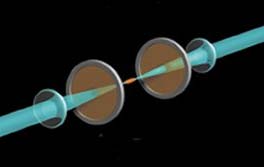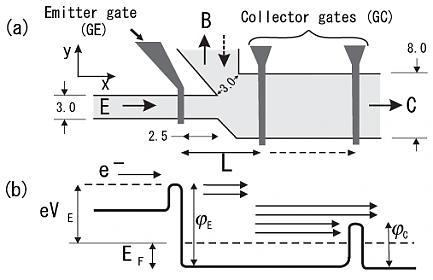Negative resistors are found in 2-dimensional electron gas
 Any physicist who begins to study physics knows that resistance against a flow has a direction of charge, and the resistor is already a positive quantity. But Turkish and German scientists studying 2D electronic gases (2-dimensional space) at low temperatures in semiconductors have now observed evidence of ' negative resistance '.
Any physicist who begins to study physics knows that resistance against a flow has a direction of charge, and the resistor is already a positive quantity. But Turkish and German scientists studying 2D electronic gases (2-dimensional space) at low temperatures in semiconductors have now observed evidence of ' negative resistance '.
They say that this bizarre effect could be used to create microscopic sources of terahezt radiation (THz: trillions of Hezt), which are normally produced only by devices. much larger than synchrotron machines (These results can be found in Phys. Rev. Lett. 98 186801).
In a normal conductor, the current is the result of the transfer of charged particles , usually electrons, when they are applied to the electric field applied to the two poles. Along the orbit, the electrons are often hampered by ions and impurities due to collisions, which is the reason for the resistance and thus the loss of energy.
Negative resistance, therefore, is an implication that energy is somehow supplied to electrons, and makes them move faster. The problem is, energy cannot appear from nothing because it violates the first law of thermodynamics, which states that energy must be preserved in an isolated system.

Figure 1. System layout to create positive resistance effect
(Results published in Phys. Rev. Lett. 98 186801).
Ismet Kaya at Sabanci University of Turkey and Karl Eberl at Germany's Max-Planck Institute say that negative resistance can occur in a conductor containing three electrodes in a straight line . In theory, part of the energy lost by the resistor corresponding to the electrons moving from the first pole to the second pole, must be transmitted in some way for the moving electrons to cross from the second pole to the second pole. father. These energized electrons, therefore, will then move with a forward current in the opposite electric field, in other words, to have a negative resistor, while still following the first law. of thermodynamics.
A theoretical problem is that it requires some ' hot ' electrons from the first part to fall into the electron beam in the second part, where they lose their energy. But this is prevented by the Pauli exclusion principle, which ensures that electrons have uniform energy distribution in all directions. Kaya and Eberl have solved this problem by creating a long, small, 10 micro-meter structure, made from GaAs and AlGaAs, in which electrons behave like a 2D gas (bi-directional). By cooling this structure to a temperature of 4.2 K, the electrons that interfere with the first pole can immediately eliminate the principle of elimination and receive the transfer energy needed.

Figure 2. Results of negative differential resistor effect
(Results published in Phys. Rev. Lett. 98 186801).
Kaya said that the negative resistor effect could be exploited to make teraherte (THz) radiation sources simply by adding an inductance into the said structure. Terahezt radiation, the radiation zone is sandwiched between microwaves and infrared waves in the electromagnetic wave, which could one day allow data to be transmitted at extremely high speeds, but currently it was only created in very large and expensive devices such as synchrotron particle accelerators.
Elektron
According to Physcal Review Letters & PhysicsWeb.org, Vietnamese Physics
- Scientific methods help limit negative thoughts to live better
- New record of electron diffraction
- New Zealand: Successfully tested the Electron boosters
- Spintronic memory breakthrough
- Physicists create a device that can 'forget memories'
- Find a method of 'immunity' with a sad mood
- Scientists have found a way to take photos across walls through Wi-Fi
- Evidence shows that the universe is a three-dimensional projection
- Great invention: Found legendary nuts
- Latest three-dimensional map of the universe
- Gene regulates negative reactions in humans
- Detection of bacteria 'eat' electrons
 Daily use inventions come from universities
Daily use inventions come from universities Special weight loss device helps prevent appetite
Special weight loss device helps prevent appetite 8 inventors were killed by their own inventions
8 inventors were killed by their own inventions Iran invented a motor car powered by water
Iran invented a motor car powered by water